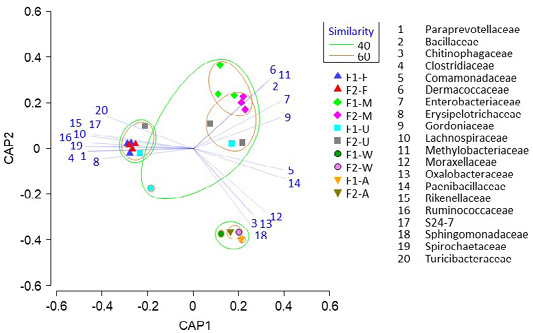Fecal, Milk, Uterine, Airborne Dust, and Water Microbiota in Dairy Farms in Southern Vietnam: A Pilot Study
Fecal, Milk, Uterine, Airborne Dust, and Water Microbiota in Dairy Farms in Southern Vietnam: A Pilot Study
Tu Thi Minh Tran1*, Diep Hoang Tran1, Thuong Thi Nguyen2, Tomas J. Acosta3, Takeshi Tsuruta4, Naoki Nishino4, Hai Thanh Duong5
Heatmap analysis showing hierarchical clustering of the relative abundance of the 30 most occurring OTUs in the fecal, milk, uterine, airborne dust, and water microbiota in dairy farms.F, fecal samples; M, milk samples; U, uterine samples; A, airborne dust samples; W, water samples; 1–2, the farm number.The color of each cell indicates the relative abundance of the bacterial family.
Principal coordinate analysis exploring the differences betweenfecal, milk, uterine, airborne dust, and water microbiota in dairy farms. The operational taxonomy unit with Pearson’s correlation >0.7 is overlaid on the plot as vectors. F, fecal samples; M, milk samples; U, uterine samples; A, airborne dust samples; W, water samples; 1–2, the farm number.







